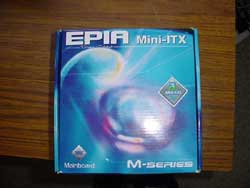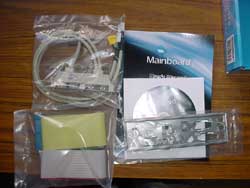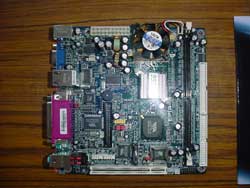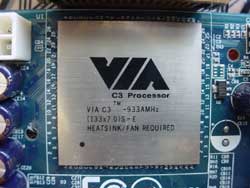|
|
|
|
|
VIA "Eden" EPIA-M (933 MHz C3) |
|
Join the community - in the OCAU Forums!
|
Introduction, In The Box, First Impressions
Last year, VIA brought us one of the smallest commercially available motherboards (barring, of course, those proprietary matchbox type boards.) Unfortunately, it was something of a letdown, mainly related to video performance and DVD playback. VPSD (VIA's in-house motherboard manufacturer) have addressed these concerns with the release of their new board, the EPIA-M. This low profile Mini-ITX form factor motherboard has been greatly improved from its predecessor.

Review system specs:- Seasonic SS-140NQ Low Profile 140W PSU (kindly supplied by VIA Arena)
- 256mb PC-2100 Micron DDR-RAM
- Pioneer DVD-117 16x DVD-ROM
- Seagate ST340016A "Barracuda IV" 40gig, 7200RPM, ATA-100 Hard Disk Drive
What’s in the box:

1x VPSD EPIA-M Motherboard
1x Motherboard Driver and Utility CD
1x ATA-66/100 IDE Cable
1x Floppy Cable
1x USB-2 and FireWire Backplane (with 2x USB-2 ports, and 2x Firewire ports.)
First Impressions
As with the original EPIA, the EPIA-M is a Mini-ITX Form Factor motherboard. The size of the motherboard is 170mm x 170mm, which makes it perfect for use either in a small case, or in a case mod, as I have done and will show you in a future article. To get an idea of scale in the picture below, note the size of the board compared to the PCI slots or IDE connectors.

The heatsink installed on the processor is the same that appeared on the original EPIA, a gold anodized low profile heatsink with a low-noise AVC C4010T12H fan installed. This fan has two bearings - one ball and one sleeve. It runs at 6200RPM, pushing a mere 7.87 cubic feet of air per minute. The fan only produces 29 dB of noise, so on its own the board is near-silent. The heatsink is attached via 2 push-pins as found on most video cards and chipset coolers. I don't have one to test it with, but from what I've heard about the EPIA, it was possible to replace the heatsink and fan with a Zalman chipset cooler, which allowed for passive operation. The new C3-E CPU puts out less heat than the previous C3, so I assume that this would work quite well as a replacement on this board.
VIA have changed the CPU to the C3 E-Series processor running at 933 MHz, from the C3 running at 800 MHz on the EPIA. This processor is made on a 0.13 micron process and has the worlds smallest x86 processor die of 52mm^2. It has 128kb of integrated Level 1 and 64kb of level 2 cache running at full speed. As on the EPIA, the CPU is in a EBGA (Enhances Ball Grid Array) package, which means it is directly attached to the motherboard. This means that the CPU cannot be upgraded in the future.
This motherboard has no overclocking support. The processor runs on a 133 MHz front side bus and a 7.0 multiplier.

CPU with heatsink removed
The northbridge on the EPIA-M is the VIA CLE266. This allows front side bus speeds of 66, 100, or 133 MHz. The CLE-266 has a built in graphics chipset which allows for complete MPEG-2 (DVD) decoding and acceleration. This runs on an internal AGP 8x Bus. It also adds support for DDR-SDRAM as well as standard SDRAM. VPSD have also released a "sister" board to this one, the EPIA-N. The EPIA-N is virtually identical apart from having a single SDRAM connector instead of a DDR-SDRAM connector.
This links up with the VT8235 southbridge. This chip allows for six USB 2.0 ports (max of 4 on the EPIA-M), ATA-133, Six Channel AC-97 Sound, and a VIA 10x100 Ethernet Adapter. It also includes 8x V-Link technology, which apparently removes the PCI bottleneck in inter-chip communication. This gives the North and South Bridge a quad-pumped 133 MHz dedicated bus for communications, providing four times the speed of transfer between the two.
The TV-Out chipset has been upgraded from the VT1621 to the VT1622M chipset, supporting up to 1024x768 NTSC or PAL TV-Output. The M stands for Macrovision - which means it is not possible to output DVD's to VHS or other formats. This does not affect standard viewing - just attempted recording. Note: This does not affect non-macrovision encoded files - I've successfully transferred a DivX encoded video file to VHS with no problems. The AC97 Audio chipset has been given a kick in the pants - it is now 6 channel output capable.
A big addition to this board over the EPIA is that of a floppy drive connector. A lot of people didn't like the fact that the EPIA didn't have a floppy drive connector and VIA have stuck one back on this model. Personally, it doesn't bother me - I don't use a floppy drive anyways.
|
|
Advertisement:
All original content copyright James Rolfe.
All rights reserved. No reproduction allowed without written permission.
Interested in advertising on OCAU? Contact us for info.
|

|


